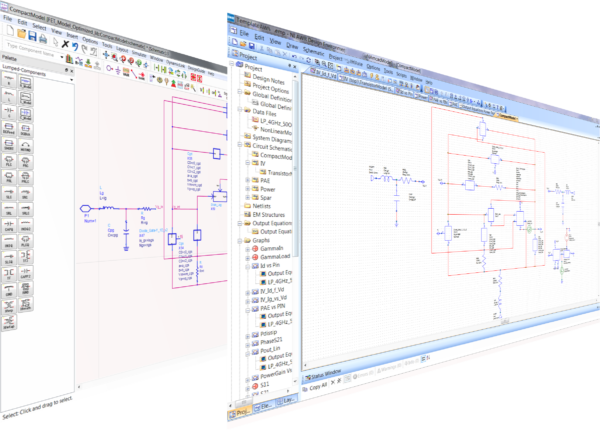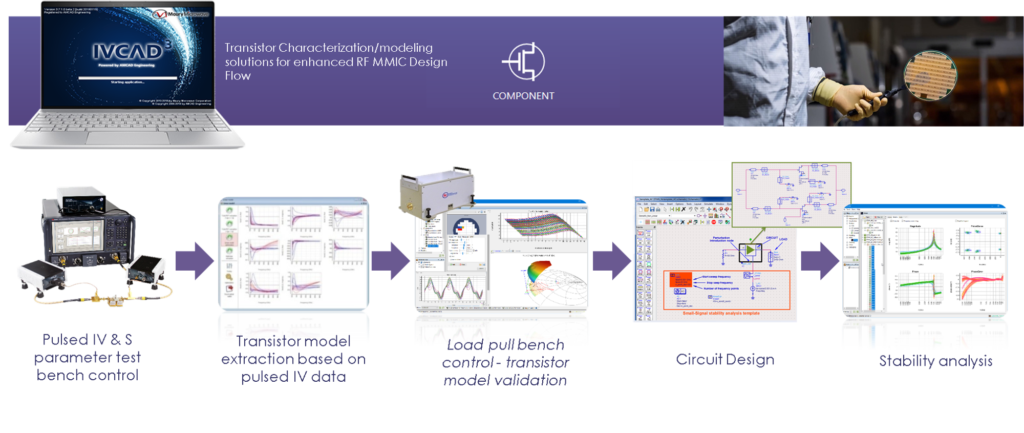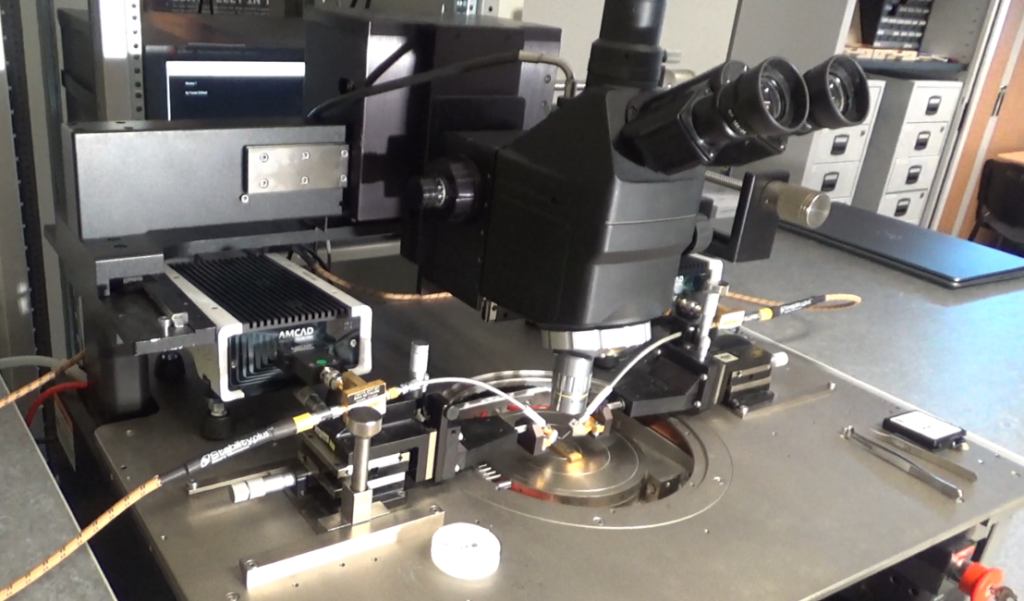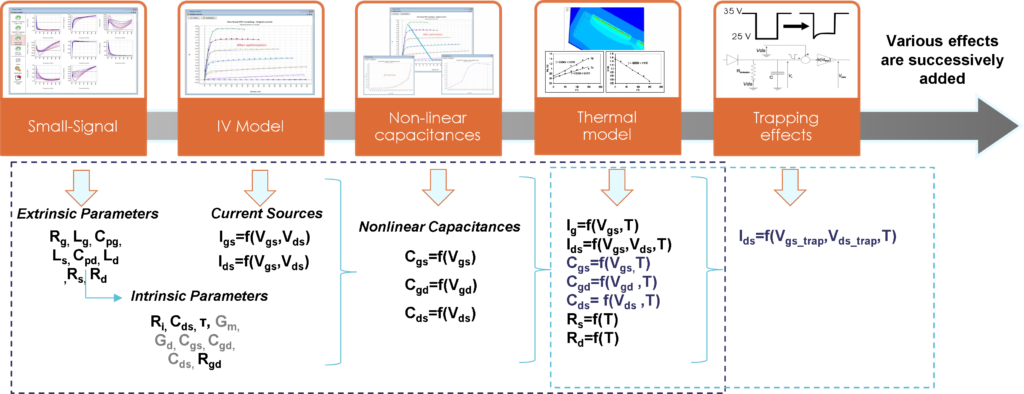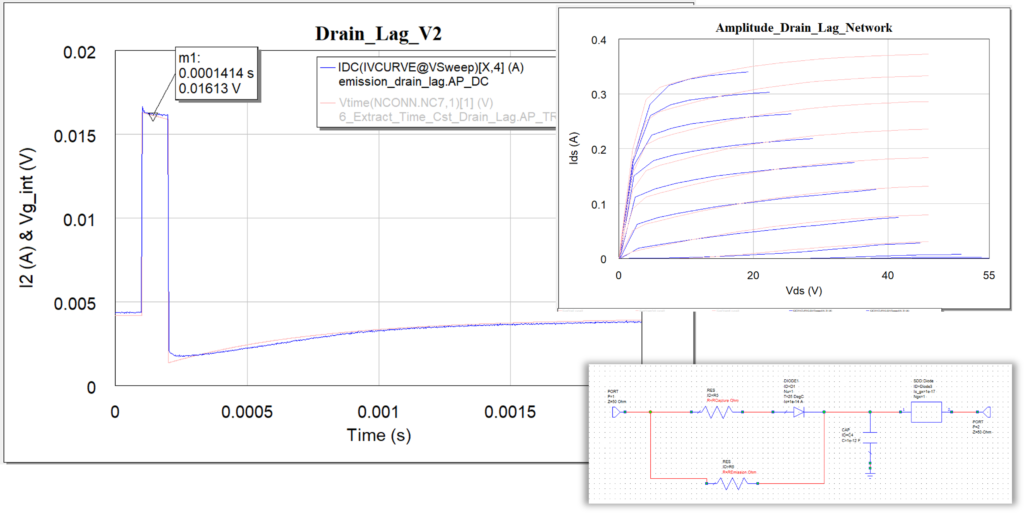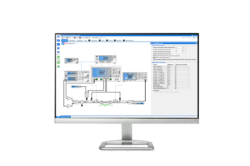RF Power Transistor Modeling Services
What is our legitimacy in the field of RF transistor modeling ?
AMCAD Engineering is a pioneering company that was the first to introduce to the market two measurement techniques which are now widely used and become common in our industry.
The first technique is the measurement of voltage and current transistor’s characteristics using very short pulses, synchronized with pulse S parameters.
Secondly, our company was also the first to democratize load-pull test benches using the receivers of vector network analyzers as the main RF receivers, thus replacing scalar load-pull test benches only equipped with power sensors. This triggered our partnership with the leader in load pull measurements, Maury Microwave.
Compact model and RF circuit simulators
Our transistor models are mainly dedicated to the design of MMICs, designed in microwave circuit simulators such as ADS or Microwave Office supplied respectively by the companies Keysight technologies and Cadence. They allow reliable and realistic simulations of circuit performance in linear and non-linear operating conditions, with fine prediction of the circuit behavior in DC current and voltage, and at microwave frequencies.
- DC simulations allow simulating IV characteristics for different operating temperatures.
- AC simulations allow the S-parameters to be plotted as a function of frequency .
- HB (Harmonic Balance) simulations allow the designer to predict the performance at high power levels for various source-load impedances.
- Transient mode : Thanks to a detailed description of the thermal and trap effects in GaN transistors, it is also possible to faithfully simulate the performance of the circuits in transient domain when modulated signals are used.
What is the point of making pulse IV measurements, synchronized with pulse S parameters ?
Power RF transistors, when tested with conventional DC continuous voltage generators, experience significant self-heating effects when tested under high power consumption conditions.
High voltages and currents can destroy the component under test.
Measuring the IV characteristics using very short pulses (a few hundred ns), with low duty cycles (<10%), eliminates these self-heating phenomena.
Systems such as our AM3200 pulse IV generator synchronized with vector network analyzers also operating in pulse mode allows the component to be tested in areas of high-power dissipation, while limiting self-heating phenomena.
Consequently , it makes it possible to collect more information on the operation of the device under test, without the risk of performance degradation or transistor breakdown.
Compared to conventional test systems, it is possible to collect much more information on the behavior of the semiconductor.
More information available means a more realistic model if this one embeds all this additional data.
Why do we offer this modeling activity as a service ?
Even with the right hardware and software tools, extracting a transistor model requires specific skill sets. It is important to proceed step by step, following a well-established methodology.
AMCAD has been providing modeling services for 15 years, and our techniques have been tested with the main RF foundries.
Our expertise in the field allows our customers to carry out MMIC designs using all the potential offered by their semiconductor technology.
For us, these exchanges are always very enriching, and give us a good overview of the state of the art RF transistor technologies. This allows us to develop modeling methodologies that remain in line with market needs.
What are the different steps to extract a model ?
The first step consists of extracting a linear model , it’s undoubtedly the most crucial step.
Indeed, if the extraction of the extrinsic parameters is not perfectly carried out, then all the following steps will be hazardous. Model extraction takes time and commitment. It is therefore mandatory that the foundations of this work are solid. AMCAD has unique know-how to extract frequency independent extrinsic parameters valid for a wide range of operations.
For different IV values, a multitude of linear models sharing the same extrinsic parameters are extracted. Then, the parameters of the equations which describe the nonlinear behavior of the components are found. Cgs, Cgd, or even Cds equations and parameters are described along the RF load lines.
Finally, the output current source controlled by the input voltage and the current diodes are also described by specific equations that can be used to calculate the transistor’s conductance (gd) and transconductance (gm) values.
This model is supplemented by an electrothermal description, which takes into account the impact of the junction temperature over the RF performances.
For GaN transistors, this process is finalized by taking into account the trap effects which can strongly impact the transient response of the transistor.
What makes our offer unique ?
The extraction of transistor models is a topic widely discussed in scientific conferences, in academic research laboratories. However, AMCAD can provide a unique expertise when it comes to working on the more delicate phases of the modeling work : the thermal and the trap models.
In addition, vector load pull measurement benches provide very valuable information for the model validation against RF power and load impedances controlled by RF tuners. Apart from simply predicting the optimum load impedance for output power or efficiency, we analyze very important information. On top of Output power versus input power (AMAM), this may be the ability to finely represent the change in the input impedance as a function of the power level and load impedances. It may also be the ability to represent phase modulation of the signal as a function of amplitude modulation (AMPM).
This is essential to estimate with confidence what will be the performances of the RF power amplifier in efficiency, power, adaptation and linearity.
We therefore make it a point of honor that our models adjust to the reference measurements which are the IV characteristics, the S-parameters, the load impedances, for different temperatures.
The know-how needed to obtain this result is our key differentiator against our competitors.
What are the types of deliverables with this modeling service?
All the measurements that allowed the model to be extracted and validated are delivered.A temporary IVCAD license which allows all these measurements to be viewed easily, in a personalized way to identify key information is offered. Finally, within the strict framework of service provision, an encoded model that can be used with the main circuit simulators is provided. ADS from Keysight or AWR from Cadence are supported. If this service is combined with the purchase of a measurement and modeling solution (IVCAD software + pulse iv measurement system + load-pull bench), a specific training is provided to our customers. This allows them to acquire our knowledge in-house.In this case, the model extracted during the service activity is open.
You hesitate to take the plunge?
How to justify the budget invested for this type of modeling service ? A quick calculation of the cost of an MMIC design that does not meet the expectations can be helpful. The time spent on this design, the cost of the tape-out, the downtime, cost of measuring instruments, etc. are often impressive if calculated seriously.
When it comes to relaunching a new design because the one doesn’t perform as expected, several months of work, and several hundred thousand dollars are in the trash basket.
It is therefore important to use these resources wisely. The best toolbox (the circuit simulator), if not used with the right tools (our models), won’t work miracles. So , instead the “Try and cut” MMIC design approach , let’s try AMCAD’s models instead.
We continue to extend our service offer as a function of your needs continuously, so please contact us if you have any requests :

